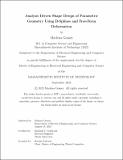Analysis Driven Shape Design of Parametric Geometry Using B-Splines and Free-Form Deformation
Author(s)
Gomez, Marlena
DownloadThesis PDF (9.124Mb)
Advisor
Galbraith, Marshall C.
Terms of use
Metadata
Show full item recordAbstract
This thesis presents a method for local aerodynamic shape optimization to morph parametric geometry. The goal is a general framework for analysis driven shape design that combines CAD-like parametric solid model geometry construction with free-form-like local deformation. One method explored uses the control point locations of certain B-splines defining the geometry as design parameters during optimization. A second approach builds on this method, using free-form deformation (FFD) to morph geometry within an FFD box. Analytic geometry inside the FFD box which is not by default defined by B-splines is converted to a B-spline representation, and free-form deformation is then used to move the B-spline control point net. In this method, the control point locations of the FFD box serve as design parameters, which allows for the generation of smooth geometry while keeping the number of degrees of freedom manageable for the optimizer. The first technique is applied to an optimization case where the 𝐿²-norm difference between an airfoil shape and a target shape is minimized. Then, the technique is demonstrated on an optimization driven by computational fluid dynamic analysis (CFD) where drag of an airfoil geometry is minimized. Lastly, the B-spline method is applied to an optimization of a wingtip surface, where the objective function minimizes drag while maintaining the initial lift of the shape. The FFD technique is similarly applied to an airfoil 𝐿²-norm difference minimization, and a wingtip 𝐿²-norm difference minimization. Finally, the FFD technique is demonstrated on design cases driven by CFD analysis for an airfoil.
Date issued
2023-09Department
Massachusetts Institute of Technology. Department of Electrical Engineering and Computer SciencePublisher
Massachusetts Institute of Technology